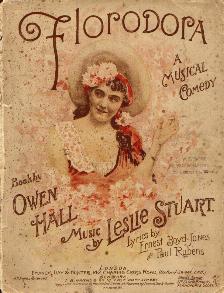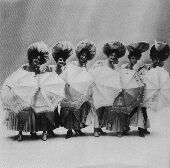
FLORODORA
Musical Theater Research Project
January, 1996Home | Plot | Music | Tell Me,Pretty Maiden
 |
FLORODORAMusical Theater Research ProjectJanuary, 1996Home | Plot | Music | Tell Me,Pretty Maiden |
Florodora opened in London on November 11, 1899, and ran for a little over one year--an impressive run for that time. But, the American production produced on Broadway the following year ran for 552 performances--over two years! This was indeed a phenomenal success since most productions at the turn of the century could run for less than a year and still achieve financial success. For a show to run 552 performances, it had to attract not only a return audience, but also catch the attention of that newest of commodities--the American tourist. And, it was this new class of entertainment seekers who would eventually target Broadway as the theatrical Mecca of the world.
 Florodora
had more to offer the theater-going public than good tunes and spectacular
sets. Florodora, like The Black Crook before it, had plenty
to offer--Girls! Girls! Girls! "The most beautiful women on the stage,"
wrote one critic. A sextet of women (called the "English Girls" in the
score, but remembered today as "The Florodora Girls") guaranteed a sellout
at every performance. Their number, Tell
Me, Pretty Maiden, a double sextet with six men, was the highlight
of the evening. Young men were said to crowd the theater each evening and
lavish expensive gifts upon the chorus girls. Others bought front row seats,
arriving just in time to hear the sextet and leaving after the last encore.
Needless to say, many a Florodora Girl found and married a wealthy admirer.
So many, in fact, that more than 70 women replaced the original sextet
during the run of the original Broadway production.
Florodora
had more to offer the theater-going public than good tunes and spectacular
sets. Florodora, like The Black Crook before it, had plenty
to offer--Girls! Girls! Girls! "The most beautiful women on the stage,"
wrote one critic. A sextet of women (called the "English Girls" in the
score, but remembered today as "The Florodora Girls") guaranteed a sellout
at every performance. Their number, Tell
Me, Pretty Maiden, a double sextet with six men, was the highlight
of the evening. Young men were said to crowd the theater each evening and
lavish expensive gifts upon the chorus girls. Others bought front row seats,
arriving just in time to hear the sextet and leaving after the last encore.
Needless to say, many a Florodora Girl found and married a wealthy admirer.
So many, in fact, that more than 70 women replaced the original sextet
during the run of the original Broadway production.
The book of the musical was written by Jimmy Davis under his pseudonym, Owen Hall. The music was composed by Leslie Stuart, and lyrics were provided by Edward Boyd-Jones and Paul Rubens. The success of Florodora made them rich men, but each life was met by tragedy of one sort or another. Lyricists Boyd-Jones and Rubens both died before reaching middle age. For Jimmy Davis and Leslie Stuart, the success provided them with nothing more than gambling funds, and each died penniless. But in 1899, they were at the peak of their abilities, and the quartet produced one of the few shows from that era worthy of revival today.
Unfortunately, piecing together a performing edition of Florodora for the Musical Theater Research Project was more like putting together an incomplete jigsaw puzzle. Originally, I hoped to reconstruct the score as heard on the premiere performance in London of 1899. Ultimately, the final product was much closer to the American production of 1900.
Although Leslie Stuart is given sole credit for the score, each casting change in the show brought new material written by other composers. This was a common practice of the day, but for research purposes, only proved to make a performance of the original score an impossible task. Here follows some of the many problems I encountered.
 The
order of the musical numbers in our production was based on the original
libretto of 1899 which had been deposited in the Library of Congress in
January 1900. The lyrics, and only the lyrics, were published in performing
sequence with each character identified. The Library of Congress did not
have a score, but we were fortunate to have an 1899 vocal score donated
to our music library at The Catholic University of America. This score
provided our musical arrangements.
The
order of the musical numbers in our production was based on the original
libretto of 1899 which had been deposited in the Library of Congress in
January 1900. The lyrics, and only the lyrics, were published in performing
sequence with each character identified. The Library of Congress did not
have a score, but we were fortunate to have an 1899 vocal score donated
to our music library at The Catholic University of America. This score
provided our musical arrangements.
The first of many challenges occurred when I examined the published vocal score against the original libretto. Both were published in 1899, and both made reference to the first performance that year on November 11th. But, the libretto provided lyrics for songs that did not exist in the score, and the score provided supplementary material by other composers that was not included in the original libretto. Could it be possible that Florodora was revised between the publication of the vocal score and the libretto--both dated 1899? Both publications mention the first performance of November 11, 1899, and the libretto bears the Library of Congress deposit date of January 1900. Research was further hindered by the misspelling of the show’s title. The show’s name is " Florodora" and not "Floradora" as it was mistakenly catalogued many times.
The script was even more elusive; for, although a synopsis of the story was found, the script could not be located. Unfortunately, with a performance not far off, there was nothing to do but compromise. A full reconstruction would have to wait until a script could be produced. So, following the original order of the 1899 libretto, I have substituted the supplementary material provided in the vocal score for those numbers where no music currently exists. Their position in the score was determined by examining how closely their lyrics fit the situation of the missing material.
Shortly after presenting Florodora, we signed a contract with AEI Recordings to release a double CD set of our performance. Unfortunately, the recording has never been released. And so, here are a few chosen files culled from my research. I hope you enjoy viewing the material as much as I enjoyed discovering this charming musical comedy. I am indebted to the staff members of the Music Library at Catholic University and the Library of Congress for their assistance in piecing this production together.